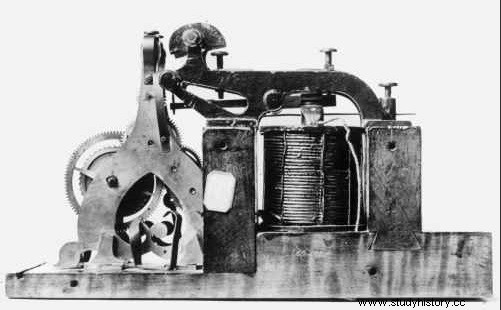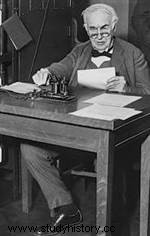 Among the earliest applications of electrical science was the invention of the telegraph usher in a new era, that of globalization. It's French Claude Chappe who developed the semaphoric telegraph at the end of the 18th century. This message transmission system, first optical, will become electric a few decades later at the instigation of the American Samuel Morse. Distances are abolished and time becomes universal. Between technique and politics, telegraph engineers succeeded in making communication a common cause for humanity. The lines cross the borders and in 1865, twenty European States create in Paris in 1865 the International Telegraphic Union
Among the earliest applications of electrical science was the invention of the telegraph usher in a new era, that of globalization. It's French Claude Chappe who developed the semaphoric telegraph at the end of the 18th century. This message transmission system, first optical, will become electric a few decades later at the instigation of the American Samuel Morse. Distances are abolished and time becomes universal. Between technique and politics, telegraph engineers succeeded in making communication a common cause for humanity. The lines cross the borders and in 1865, twenty European States create in Paris in 1865 the International Telegraphic Union
Chappe's Telegraph
 Inaugurated in 1794 between Paris and Lille, the Chappe aerial telegraph can be considered the first modern telegraph network. Admittedly, remote communication is long before the French Revolution. But the system developed by the French engineer Claude Chappe presents itself as the first system comparable to current electric telegraphs. It was an optical telegraphy system, consisting of a mobile mast carrying articulated arms. Communication is done using signals emitted by the arms and reproduced by each operator to the destination. Establishing a code for transmitting complex messages, Chappe had the ambition to cover all of France with this network.
Inaugurated in 1794 between Paris and Lille, the Chappe aerial telegraph can be considered the first modern telegraph network. Admittedly, remote communication is long before the French Revolution. But the system developed by the French engineer Claude Chappe presents itself as the first system comparable to current electric telegraphs. It was an optical telegraphy system, consisting of a mobile mast carrying articulated arms. Communication is done using signals emitted by the arms and reproduced by each operator to the destination. Establishing a code for transmitting complex messages, Chappe had the ambition to cover all of France with this network.
Morse and the invention of the electric telegraph
In the 19th century, the development of electricity enabled an American named Samuel Morse to invent a new system for transmitting messages, which would replace that of Cope. However, nothing could have led to believe that Morse would achieve such a technological breakthrough. Painter by training, Samuel Finley Morse has always been interested in electricity, of which not much was known at the time.
In 1829, he went to Europe to complete his artistic education and stayed there for three years. On the boat taking him back to the United States, he overhears a conversation about the electromagnet that André-Marie Ampère has just invented. He then had the idea of making an electric telegraph using a simple code. As soon as he returned, he began to work on a prototype, which was completed in 1835. Two years later, Morse teamed up with mechanic Alfred Vail and managed to make his electric telegraph work. In 1838, Morse developed the famous "Morse code", made up of lines and dots separated by spaces. After several attempts, he finally manages to obtain the support of the United States Congress, which allocates him 30,000 dollars to build an experimental telegraph line between Washington and Baltimore.
The first telegram
On May 24, 1844, Morse sent his first telegram from the US Supreme Court. The message then transmitted is:“What God wrought” (“What hatli God wrought”). Shortly after, the system developed by Samuel Morse is essential in the whole world. In 1866, the laying of an undersea cable in the North Atlantic reduced the communication distance between London and New York by a few hours.
 From the 1850s devices were designed that used the characters of the alphabet, and no longer a code particular signs. The Hughes system, patented in the United States in 1855 and produced in Paris, made it possible to write a message on a 28-key keyboard. The message was printed directly by the receiver, thanks to a clockwork synchronized with the keyboard of the transmitter. The Hughes Telegraph had an average throughput of 45 words per minute. The most efficient system was developed in France by Émile Baudot in 1874. The inventor imagined a 5-key keyboard, allowing faster input. He thus increased the average speed to 60 words per minute. The Hughes system and its improvements were very successful and were used until the early 1950s.
From the 1850s devices were designed that used the characters of the alphabet, and no longer a code particular signs. The Hughes system, patented in the United States in 1855 and produced in Paris, made it possible to write a message on a 28-key keyboard. The message was printed directly by the receiver, thanks to a clockwork synchronized with the keyboard of the transmitter. The Hughes Telegraph had an average throughput of 45 words per minute. The most efficient system was developed in France by Émile Baudot in 1874. The inventor imagined a 5-key keyboard, allowing faster input. He thus increased the average speed to 60 words per minute. The Hughes system and its improvements were very successful and were used until the early 1950s.
Finally, duplex telegraphy, invented in 1874 by Thomas Alva Edison, was another milestone in the development of telegraphy. It made it possible to automatically transmit messages on another line, without the intervention of an operator.
The development of telegraph lines...
The first commercial electric telegraph line was laid along a railway line in England in 1838. Information now travels faster than trains. Faster than men and their vehicles, without which she could not travel until then - except to embark on a pigeon or to signal smoke, light, or arm movements of the semaphoric telegraph Chappe, necessarily within reach limited. This property of the electric telegraph allows railway traffic regulators to avoid collisions, and soon other users to enjoy enormous time savings. The transmission of news is accelerating phenomenally.
In the mid-19th century, engineers tried to make telegraph lines across the oceans. The first submarine link was the Dover-Calais line, opened in November 1852. On the other hand, crossing the Atlantic proved more difficult. After an unsuccessful attempt in 1858, the first line was put into service in 1866. It was then the beginning of a progress never slowed down. The United Kingdom thus developed an extremely extensive intercontinental network, which at the beginning of the 20th century included nearly 250,000 km of telegraph lines.
Months and weeks become days and hours. Where a letter took 15 days to cross the North Atlantic by sail or steam, a telegram arrives in a few hours from London to New York after the laying of an undersea cable in 1866. The invention of the wireless telegraphy (TSF) by Marconi in 1895 opens a new era of communication:that of radio.
... at the origin of the first globalization
More deeply above all, the telegraph revolution is due to the desynchronization of informational and material times, which it operates on a large scale. Skyrocketing productivity of maritime transport (boats stay docked for less time), financial and speculative innovations (the cotton futures market opened in New York in 1870; tickers constantly scroll stock market quotations), standardization of universal time ( Greenwich Mean Time):the main ingredients of a new globalization emerge with the telegraph, conveying feelings of immediacy and globality characteristic of the second half of the 19th century.
Many even see in the telegraph the possibility of a world government, while in practice it imposes itself as a diplomatic and strategic tool at the heart of power relations. It is in the British Empire that the telegraph will know its hour of glory. Deployed throughout Queen Victoria's empire, and especially in India, the telegraph established itself as a diplomatic and strategic tool by accelerating communications over long distances. It serves in particular British imperialism, which it allows in particular to hold India despite a large numerical inferiority. Not without a feedback effect, since at the same time it prepares for the emergence of an Indian public opinion, by linking distant localities now irrigated by the same flow of information... A taste of the effects of the Internet.
Bibliography
- History of telecommunications in France, by Catherine Bertho. Eres, 1984. .
- The Fabulous History of Inventions - From Mastery of Fire to Immortality. Dunod, 2018.
